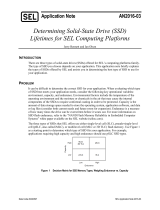
UC-8410A Series CCG V 2.0 Page 4 of 7
Cyclic High-Low Temperature Burn-In
The component is mounted on to an UC-8410A computer, placed in a temperature controlled
enclosure, and then put through the burn-in test wherein the temperature is cyclically varied from
very high to very low and back again, over a specified period of time. The target temperature range
and the duration of the test can vary depending on the specification of the computer model used in
the test.
Vibration Test
The component is mounted on to an UC-8410A computer that is bound inside an electromagnetic
vibrator, and then put through random vibration tests along three orthogonal axes: longitudinal,
transverse, and vertical. The vibration tests are compliant with the EN50155/IEC61373 vibration
standards.
3. Storage Endurance
Storage media, such as SSDs, CF cards, SD cards, Disk on Module, and Cfast, are composed of
different electrical components. The main electrical components in these storage media, the
NAND-flash memory and NAND-flash controller, impact the storage endurance and lifespan of the
storage media.
NAND-Flash Memory Endurance
NAND-flash memories have a limit on the number of times they can be programmed and erased
(P/E). The P/E cycle as well as the erase count can be used to determine this limit. For example,
an SLC (single-level cell) flash memory has a 60,000 P/E cycle, an MLC (multi-level cell) flash
memory has a 3,000 P/E cycle, and TLC NAND flash memories have P/E cycle values up to 1,000.
Each flash memory type has a different endurance level, which is why the storage lifespan is based
on the flash memory type. Storage that uses SLC type flash memory could have the best
endurance level compared with the MLC type storage. SLC storage usually comes with a 5-year
OEM warranty (the actual warranty period depends on the original manufacturer). MLC storage
only comes with a 1- to 3-year warranty. The major differences between SLC and MLC are: (a) The
SLC NAND flash has a lifespan that is around 20 times that of an MLC, and (b) The price can differ
by a factor of 4 to 5. The SLC type of storage is recommended for systems that are expected to
have high reliability, and for applications that need to frequently write data to a storage medium.
Terabytes Written (TBW)
TBW is the unit used to evaluate SSD endurance. In actual applications, storage is used for routine
operations and data access. Therefore the physical P/E cycle is not appropriate for describing the
total rewritable data capacity. The management efficiency of the storage controller also affects the
total rewritable data capacity result. For these reasons, Joint Electron Device Engineering Council








